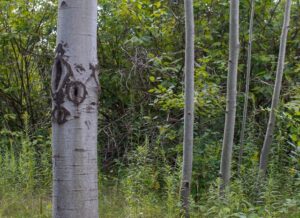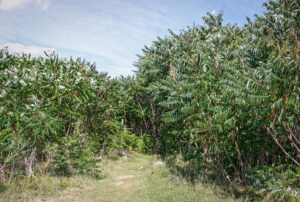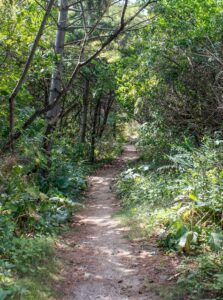The location I have chosen for observation is Hunter’s Point (43.833833, -79.441253), a small wildlife park hidden amongst my bustling City of Richmond Hill, York Region, Ontario. The park is 22888.30 m² in area and is mostly flat, with some areas dipping down into the deeper troughs of the valley. The park is segmented by walking trails but lacks direct water sources such as ponds or rivers. The park is forested, adjacent to a large municipal park with a baseball diamond, playground, and open picnic area. Hunter’s point contains a large patch of sumac plants with paths weaving between them. There are a variety of trees, such as basswood, Ironwood, and Red Oak trees, and the park hosts a diverse ecosystem containing birds, reptiles, insects, and mammals. I performed my observation hike on May 8th, 2024, at 4:40 pm. The weather was sunny with clear skies, and the temperature was 16 degrees Celsius with 64% humidity.
Walking through the relatively small wildlife park, I noticed it was not busy and did not encounter other people on the trails. The park is surrounded by human development. Backyards line most of the trail, with the opposite side bordering Highway 7, one of York Region’s busiest roads. The sound of passing cars was distinct and loud enough to disturb the quiet of the hike. Furthermore, bird feeders hang from one of the larger trees along the primary trail. During the hike, there were very few animal sightings. I saw a small rabbit which scurried away when it sensed my presence. Additionally, I sighted a few birds, including one blue jay, a mourning dove, and a couple of downy woodpeckers. The vegetation remained unchanged along most of the path besides the sumac patch. I wonder what causes the sumac trees to dominate such a large area, keeping a segregated section all to themselves. My sighting of the downy woodpeckers was supported by holes in many of the trees at the park.
Three Questions:
- How does the constant disturbance of human development impact the animal behaviours and interactions within the park? Since the park borders a highway, how does the constant noise of traffic, cars, and other overbearing aspects of human development impact the animals in the wildlife park?
- The bird sightings all occurred within the same park section, closer to the backyards on the opposite end. I wonder if the plant and tree species in this area may possess different insect compositions or other resources that would benefit birds hunting, nesting, and laying eggs.
- What causes Sumac trees to dominate a segregated park section, with no other species in this area? Could soil quality in this area be more optimal for sumac growth? Or could this be an example of ecosystem succession within the wildlife park?


